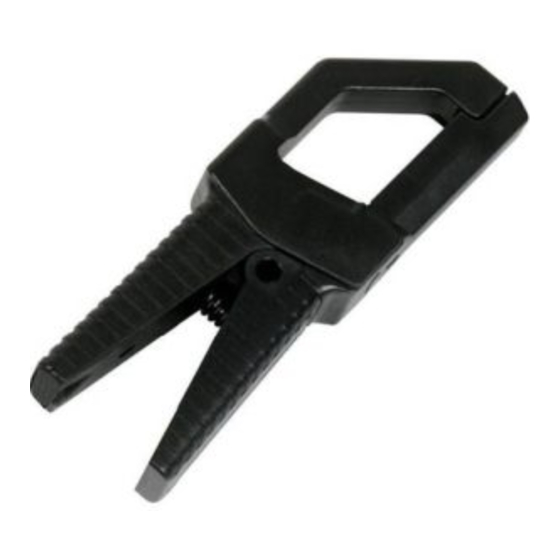
Table of Contents
Advertisement
Quick Links
AC Current Probe
Model MD304
User Manual
DESCRIPTION
The Model MD304 (Catalog #1201.37) is designed for use in industrial environments. The
hook-shaped jaws enable the user to "pry" into or "hook" onto cables (will accept 2 x 500 MCM)
or even smaller bus bars. The current output up to 500 Arms continuous makes it the perfect
tool for measurement with DMMs, recorders or instruments with current ranges. The Model
MD304 offers a 5 ft lead with safety 4 mm banana plugs.
WARNING
These safety warnings are provided to ensure the safety of personnel and proper operation of the instrument.
•
Read the instruction manual completely and follow all the safety information before attempting to use or
service this instrument.
•
Use caution on any circuit; high voltages and currents may be present and may pose a shock hazard.
•
Read the Safety Specifications section prior to using the current probe. Never exceed the maximum
voltage ratings given.
•
Safety is the respondibility of the operator.
•
ALWAYS connect the current probe to the display device before clamping the probe onto the sample
being tested.
•
ALWAYS inspect the instrument, probe, probe cable, and output terminals prior to use. Replace any
defective parts immediately.
•
NEVER use the current probe on electrical conductors rated above 600 V in overvoltage category III
(CAT III). Use extreme caution when clamping around bare conductors or bus bars.
INTERNATIONAL ELECTRICAL SYMBOLS
This symbol signifies that the current probe is protected by double or reinforced
insulation. Use only factory-specified replacement parts when servicing the instrument.
This symbol signifies CAUTION! and requests that the user refer to the user manual
before using the instrument.
This symbol signifies that this is a type A current sensor and that application near and
removal from HAZARDOUS LIVE conductors is permitted.
DEFINITION OF MEASUREMENT CATEGORIES (CAT)
CAT IV: For measurements performed at the primary electrical supply (< 1000 V), such as
primary overcurrent protection devices, ripple control units, or meters.
CAT III: For measurements performed in the building installation at the distribution level, such
as hardwired equipment in fixed installation or circuit breakers.
CAT II: For measurements performed on circuits directly connected to the electrical
distribution system, such as measurements on household appliances or portable
tools.
RECEIVING YOUR SHIPMENT
Upon receiving your shipment, make sure that the contents are consistent with the packing
list. Notify your distributor of any missing items. If the equipment appears to be damaged, file a
claim immediately with the carrier, and notify your distributor with a detailed description of any
damage immediately.
Advertisement
Table of Contents

Summary of Contents for AEMC instruments MD304
- Page 1 User Manual DESCRIPTION The Model MD304 (Catalog #1201.37) is designed for use in industrial environments. The hook-shaped jaws enable the user to “pry” into or “hook” onto cables (will accept 2 x 500 MCM) or even smaller bus bars. The current output up to 500 Arms continuous makes it the perfect tool for measurement with DMMs, recorders or instruments with current ranges.
- Page 2 CURRENT PROBE - MD304 DRAWING ELECTRICAL SPECIFICATIONS (*Referenced conditions: 23 °C ± 5 °K, (20 to 75) % RH, external magnetic field Current Range: < 40 A/m, no DC component, no external (1 to 600) A current carrying conductor, test sample Transformation Ratio: centered.) 0.1 Ω...
- Page 3 Please make sure that you have already read and fully understand the WARNING section on page 1. Making Measurements with the AC Current Probe Model MD304 • Connect the black and red terminals to the Ampere AC range of your DMM or current measuring instrument.
- Page 4 MAINTENANCE Warning • For maintenance, use only original replacement parts. • To avoid electrical shock, do not attempt to perform any service on the device unless you are qualified to do so. • To avoid electrical shock and/or damage to the instrument, do not allow water or other foreign agents to come into contact with the probe.
















Need help?
Do you have a question about the MD304 and is the answer not in the manual?
Questions and answers